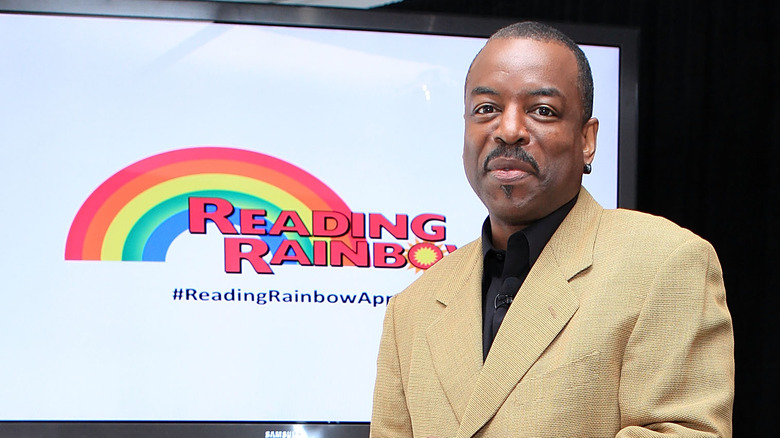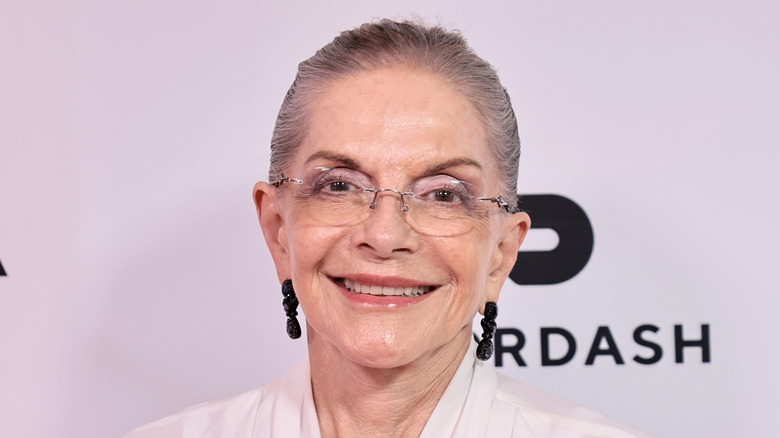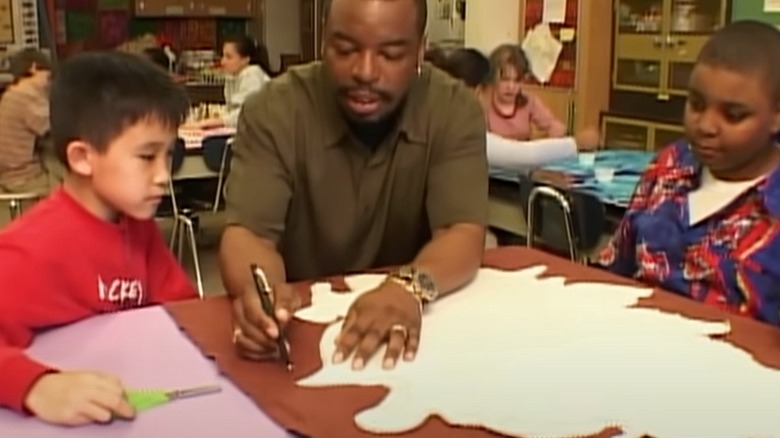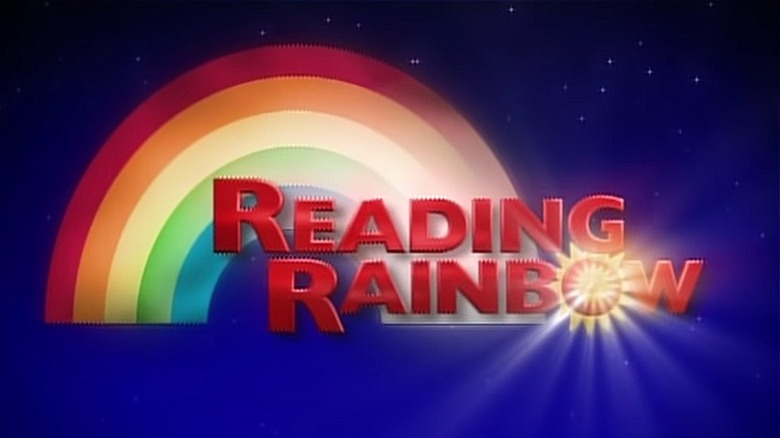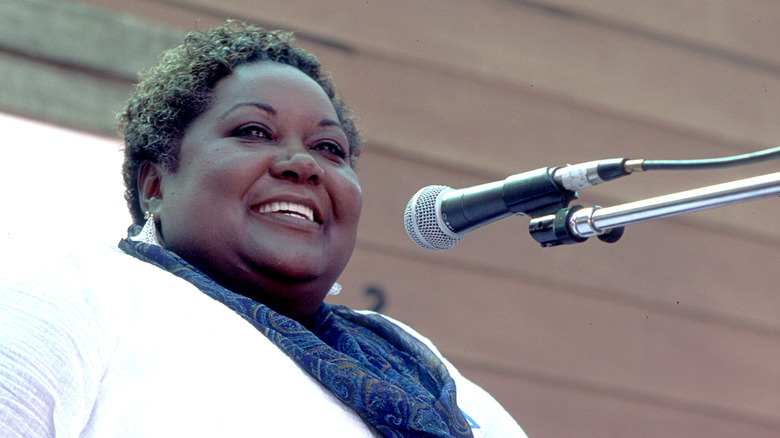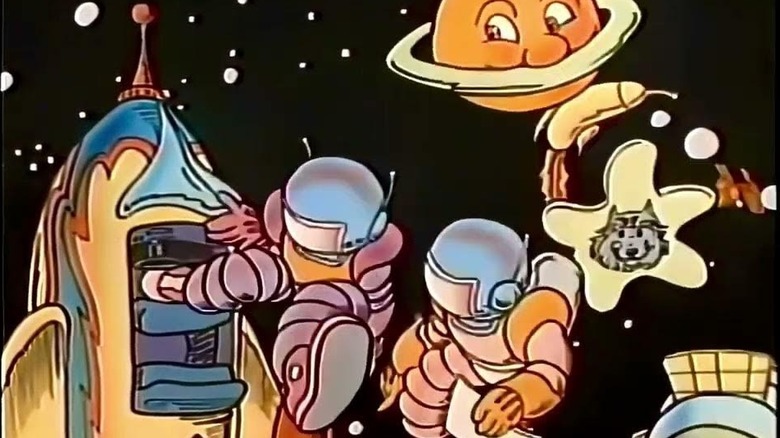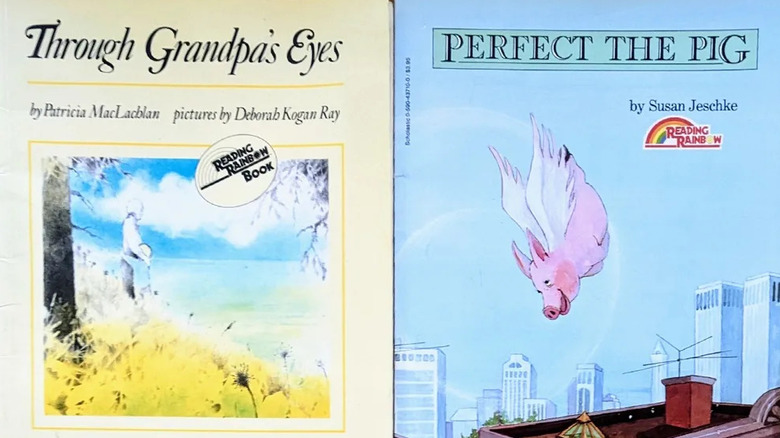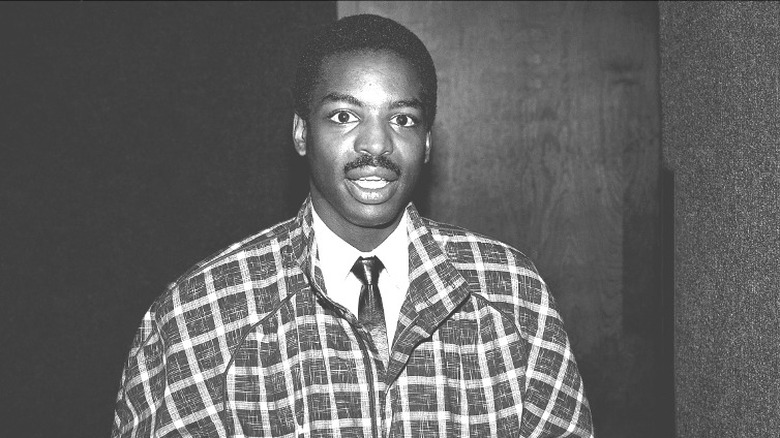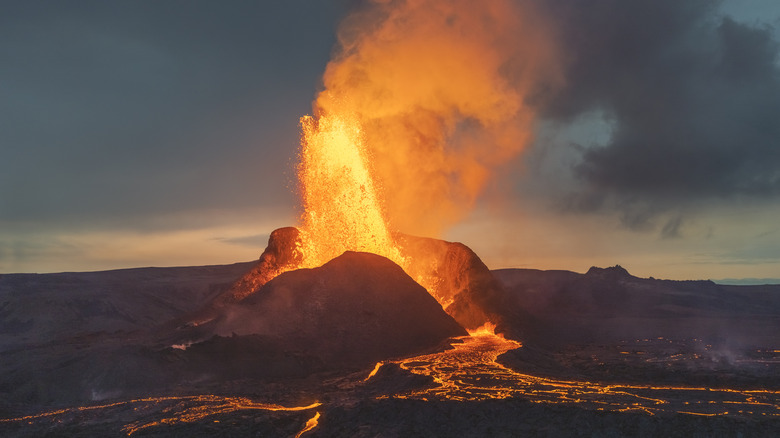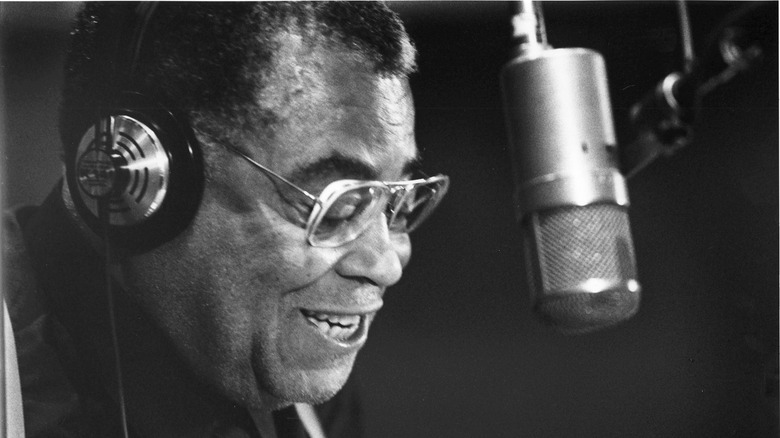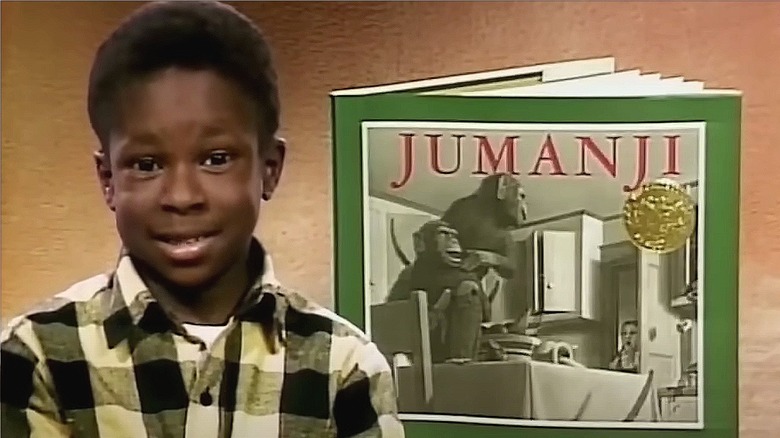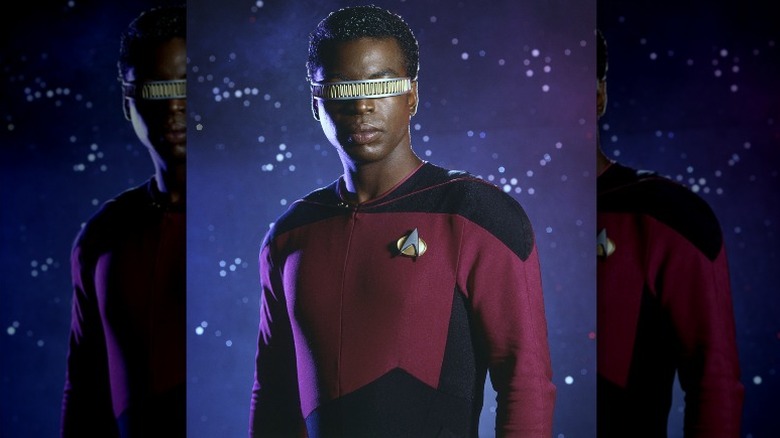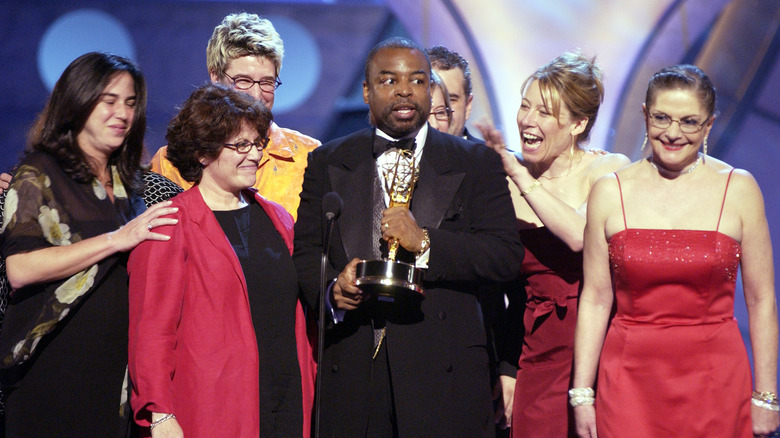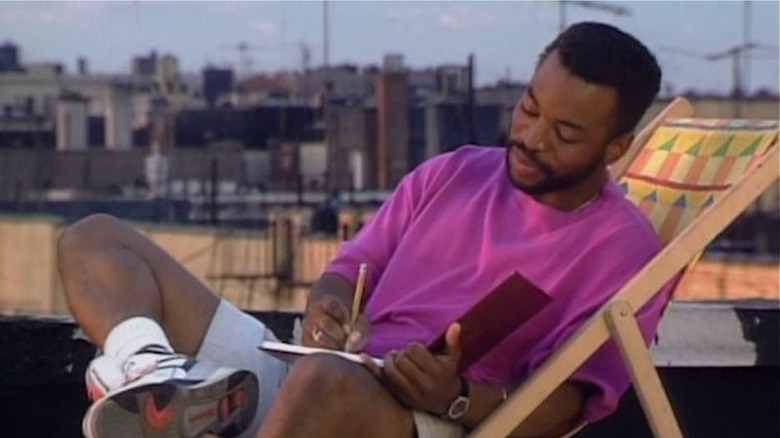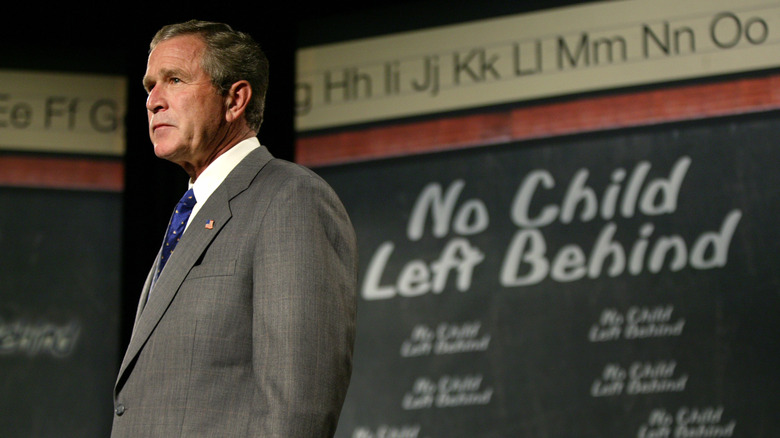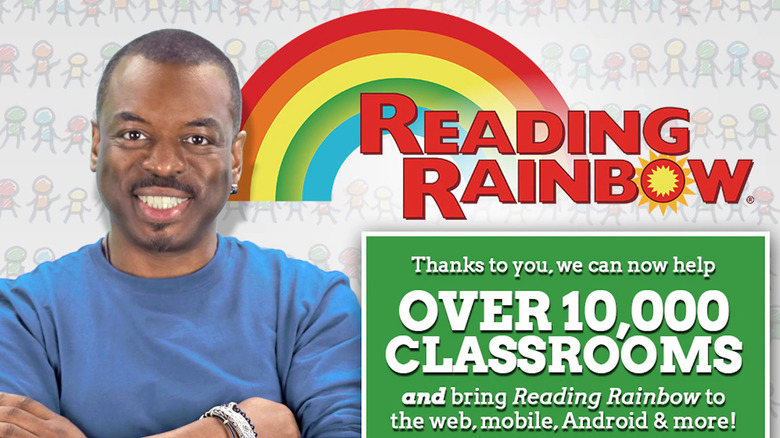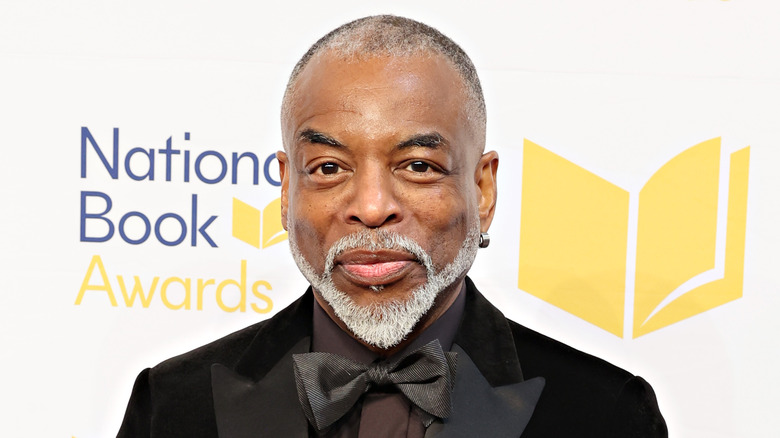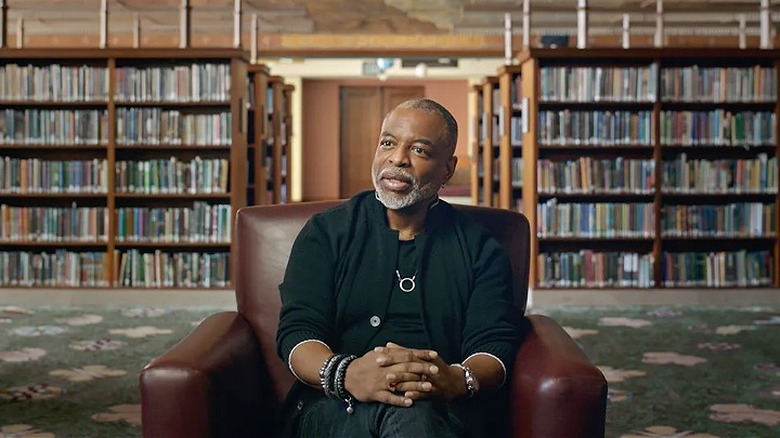The Untold Truth Of Reading Rainbow
Quickly following its debut in 1983, "Reading Rainbow" grew to become one of the most popular programs in the history of public broadcasting. Initially designed as a way to combat declines in child literacy during the summer months, this ragtag PBS series became a year-round hit that encouraged children to use reading as a way to explore the larger world around them. Hosted by LeVar Burton, the series featured original music, engaging documentary segments, and even children reviewing books themselves. All of this made for a smash hit not only in classrooms worldwide but within the television industry, garnering 100 Emmy Award nominations and several wins.
Despite the overwhelming popularity during its heyday, the series now sits in the shadow of other children's television giants like "Sesame Street" and "Mister Rogers' Neighborhood." It was unceremoniously canceled in 2009 and has yet to receive a widespread revival, however this quiet disappearance should not take away from the show's quietly subversive history. Though often produced by the skin of its teeth, the series consistently challenged the standards for children's programming and persevered to do so even in later seasons. Here are just some of the most fascinating tidbits buried within the now 40-year legacy of "Reading Rainbow."
Reading Rainbow was created by a woman with no prior television experience
There are many unlikely heroes behind the conception of "Reading Rainbow," most prominently Twila Liggett, a state reading coordinator from Nebraska. After completing her doctorate at the University of Nebraska, her talent for writing grants led her to apply for a job at her local television station, Nebraske Education Television (NETV). There was just one problem: "I had no TV experience," Liggett humorously told Variety. "I read books on how to interview and structure my resume for a job in television and got hired in project administration and development."
When NETV expressed an interest in producing original programming, Liggett planted the seed that would become "Reading Rainbow." Though there were already shows on the air that engaged children in reading, Liggett did not think any of them had reached their full potential. "I wanted to do something to mirror what I did in the classroom," Liggett explained to Mental Floss, "which was read to kids out loud, get kids involved in the experience of reading, and have kids talk to each other about reading." "Reading Rainbow" was so effective that it could have only been designed by someone in the world of education.
The show was inspired by the Summer Slide
Tony Buttino was the director of educational services at Buffalo Toronto Public Media (WNED), a PBS-affiliated television station in Buffalo, New York. He was doing research on a phenomenon commonly known as the "Summer Slide," during which children's reading comprehension decreases due to a lack of summer education. "When [students] come back to school in the fall, teachers spend two to three weeks bringing them back to their past reading level," Buttino told Mental Floss. In speaking to local educators, Buttino saw the need for a summer television series that inspired a love of reading.
Buttino began airing pre-existing shows that incorporated reading, but none of them were at the level of quality he desired. WNED began exploring the possibilities of original programming, which led them to partner with Nebraska's NETV. Buttino and NETV's Twila Liggett had similar goals for what they wanted out of their new series, which would become a part of WNED's summer block of programming. By 1989, the series became so popular that it would air outside of the summer months and even be used within classrooms during the school year.
Reading Rainbow was originally designed for inner-city children
In Mental Floss' oral history of "Reading Rainbow," show writer Lynne Ganek revealed that part of the show's inception was to target urban communities and families. "The original mission was to create a summer series for inner-city kids who couldn't go to camp to remain interested in reading." Though the series would be made broad enough to appeal to audiences of all backgrounds, this original approach colored the types of books and topics featured on the series. Because inner cities house more diverse populations, Twila Liggett sought to reflect that in the series. As Liggett writes in her "Reading Rainbow Guide to Children's Books," co-authored by Cynthia Mayer Benfield, "We have a special interest in good stories featuring protagonists who represent a cross-section of cultures –– African-American, Hispanic, Asian, and Native American."
The entire series, by extension, kept diversity at the forefront. The documentary segments often immersed viewers in specific ethnic cultures; the first season alone included episodes on Chinese mythology and the histories of Indigenous tribes. Children featured on the show's review segment were often children of color. Most importantly, LeVar Burton was chosen to be the show's host because the creators sought to have a person of color as the face of the series. "Reading Rainbow" was interested in representation far before it became a hot topic and it remains a part of the show's lasting legacy.
The title came from an unknown intern
Some viewers may wonder where the name "Reading Rainbow" comes from. It's a catchy title, but the series has nothing to do with rainbows, so what's the story? Well, the answer isn't very satisfying, ultimately. According to co-creator Tony Buttino, the name was simply suggested by an intern at WNED, the PBS-affiliated television station co-producing the series. The name of the intern remains unknown to this day. Whoever they are, they're due some serious credit.
That said, it isn't quite that simple. Part of the title originated from the creators' interest in including alliteration, as they believed that would attract children to the series, as well as the word "Reading." It's possible the creators took a tip from "Ride the Reading Rocket," a progenitor of "Reading Rainbow" that previously aired on WNED. However, it's also possible that the term "rainbow" came from the show's inclusive mindset. Though co-opted by the LGBT movement in the 1970s, the rainbow has always been a symbol of diversity and social change. By calling the show "Reading Rainbow," it showed that children of all colors and creeds could come together and unite through the power of reading.
LeVar Burton was not the producers' first choice to host the show
It may be heresy to suggest it, but beloved television icon LeVar Burton was not the creators' first choice to be the host of "Reading Rainbow." Before Burton, there was Jackie Torrence, a renowned storyteller who traveled the world year-round performing stories for children and their families. Once described as "the matriarch of storytelling in America" (via The LA Times), Torrence had already amassed experience on television and would have made for a captivating host. However, because boys were statistically more likely to fall victim to the Summer Slide, the show's creators pivoted toward a male host.
After watching an interview with Burton on television, the show's creators met the television icon at a children's television conference and pitched him the idea for "Reading Rainbow." Burton, who had found overnight success starring in the ABC miniseries "Roots," experienced firsthand the power of television as a medium for change and was raised with a love of reading instilled in him by his mother. For him, to sign on was a no-brainer. "I'm acutely aware of how literature has shaped my life," Burton told the Television Academy Foundation. "The idea of using television to steer children back in the direction of literature and the written word just made so much sense to me."
Butterfly in the Sky was television's first all-electronic theme song
"Butterfly in the sky... I can go twice as high..." Everyone knows the iconic theme song to "Reading Rainbow," composed by electronic musician Steve Horelick. A graduate of Carnegie Mellon University's avant-garde music program, Horelick had just moved to New York City and found modest success working in commercials when he was offered a chance to submit a demo for the still-gestating children's series. He collaborated with lyricists Dennis Kleinman and Janet Weir, the latter of whom was inspired by her two nephews. During a recent Q&A, Horelick recalled Weir saying that "we have to create a sound that, as soon as they hear it, they'll just come sliding in front of the TV set."
To accomplish this, Horelick created the song's opening, twinkly riff using a unique synthesizer designed by West Coast instrument designer Don Buchla. "There was nothing like it anywhere in the world," Horelick told Music Dialogue. "As a matter of fact, he only made eight of them." Horelick used other Buchla synthesizers and a drum machine to fill in the rest. "There were a lot of kid's shows on the air in those days [that] were all jazz-based and rhythm section-based. We came along and did something a little different." It was the first theme song on television to be produced entirely using electronic instruments and remains one of television's most beloved themes.
Kellogg's helped make Reading Rainbow happen
Most of us know Kellogg's as the food manufacturing company behind such beloved cereals as Froot Loops and Frosted Flakes. However, they were also an early investor in "Reading Rainbow" to the point that, without them, the show would have never been made.
After writing a proposal to the Corporation of Public Broadcasting (CPB), Twila Liggett was only able to raise half of the series' desired budget for the first season, leaving $1.6 million left to be sponsored. Liggett struggled for months until a contact from Nebraska put her in touch with the CEO of the Kellogg's Foundation. Liggett presented the series to their board and they agreed to fund the remainder of the show's budget without even seeing a pilot. At long last, this capped the development process for the first season of "Reading Rainbow," which took 18 months altogether. Liggett's perseverance was what kept the project alive. "Twila was a relentless Nebraska girl with a will of steel," said producer Cecily Truett to Mental Floss. "She was indomitable."
Books featured on Reading Rainbow saw their sales skyrocket
In its infancy, the producers of "Reading Rainbow" struggled to obtain rights from publishing companies so they could feature books on the series. "In the 1980s, TV was still being discussed in academic circles as evil," LeVar Burton explained to Mental Floss. "It was seen as a direct competitor for readers."
However, as the show rose in popularity, so too did their featured books. Often labeled with the show's logo for visibility, sales of some titles skyrocketed as high as 900%. Mimi Kayden, a marketing director at E. P. Dutton, told The New York Times that "Reading Rainbow" was "the best thing that ever happened to children's books. Books that would sell 5,000 copies on their own sell 25,000 copies if they're on 'Reading Rainbow.'"
In response, publishers did an about face. "After the first season, we could barely fit all the books we were getting sent into the office," writer Lynne Ganek told Mental Floss. Demand was so high that "Reading Rainbow" would require publishers to put their book back into print if it was selected for the series, often in paperback. Suddenly, the show's creators went from beggars to choosers.
Producers once forced LeVar Burton to shave his facial hair
By all accounts, LeVar Burton was the first Black host of a nationally syndicated children's television show. He would often express his Blackness through style choices, from a subtle but fashionably pierced ear to his changing hairstyle season after season. However, early on in the show's production, his style would clash with the show's producers at the Corporation for Public Broadcasting. "From [their] point of view, a more consistent look lent itself to the sort of stability that's important for kids in their lives," Burton told Yahoo Entertainment. "But I was also very, very clear that they had hired me, and in doing so they needed to respect who I am and that I'm in control of what I look like... I wasn't willing to change that."
Things came to a head one day when the producers requested Burton shave his mustache. Burton was adamantly resistant, but the producers wouldn't back down and Burton caved. Though this incident would upset him, later seasons featured Burton in a variety of different looks, proving he ultimately got his way. "These victories are hard-won," Burton went on, "and they're hard-fought because they matter. Representation matters."
Two crew members once got stuck on an active volcano
The documentary segments on "Reading Rainbow" took viewers around the globe, often to exotic locations in the natural world. Because of this, the show's production crew were often put through the ringer in ways that felt closer to "National Geographic" than to "Sesame Street." One such episode was "Hill of Fire," which brought audiences to Mount Kilauea, Hawaii's most active volcano. The crew filmed during a live eruption, which made for sensational footage. However, it also came with safety concerns.
Much of the crew were being transported to the surface of Kilauea via helicopter. However, toward the end of the shoot, impending changes in wind speed became a flight risk. The pilot attempted to evacuate the entire crew before things got too out of control, but one video technician and one sound technician were unable to be transported back. The two wound up staying the night on Kilauea with a group of scientists studying the volcano and returned safely the next day. At "Reading Rainbow," there was truly no such thing as a "normal day on set."
James Earl Jones took Reading Rainbow seriously
Many beloved celebrities took part in "Reading Rainbow" as guest narrators for the week's featured book, from actors like Meryl Streep and Martin Short to other television personalities like Julia Child and Al Roker. The list goes on and on, but one of the most memorable narrators was the one and only James Earl Jones. Already beloved for his staggering voice work as Darth Vader in "Star Wars," Jones agreed to narrate the book "Bringing the Rain to Kapiti Plain" for the show's first season.
In the "Reading Rainbow Guide to Children's Books," co-creator Twila Liggett recounts originally recording with Jones and the incredible events that followed. "[He] originally took a lighthearted approach to his narration," Liggett explains. "However, once he thought about it and realized what an important message both the show and the book had, he called the producer and asked to do the reading again." Not only does Jones' darker, more patient vocal work give author Verna Aardema's words much more gravitas, but he had the consideration and thoughtfulness to give the "Reading Rainbow" audience a reading worthy of the material. Memories like this are a testament to just how much everyone valued the series and its message.
The show's children book reviews were done by non-professional child actors
Every episode of "Reading Rainbow" was bookended (pun intended) by a trio of additional book reviews performed by child actors. Well, calling them child actors is only half-true. They may have been children, but the kids featured on the show were not professional actors. They were merely elementary school students plucked out of obscurity via local auditions held by the show's producers. After selecting a group of students who they felt would do well on camera, the producers paired each one with a book and helped them write their own book review. Though they surely had assistance from the show's crew, every review came from their own words.
In the "Reading Rainbow" documentary "Butterfly in the Sky," now-accomplished actor Kenn Michael recalls his experience reviewing a book for the series (pictured above). "Writing that book review and then performing it... gave me a sense of ownership." Later in the film, author Jason Reynolds, who watched the show as a child, further adds to the importance of the segment. "It was saying 'You matter. Your stories matter. Your voice matters. Your opinion matters,' which means I get to watch the show and say, 'Huh, maybe I have a voice. Maybe I have an opinion. Maybe I have a story.'"
LeVar Burton filmed episodes of Reading Rainbow and The Next Generation in the same week
In 1986, LeVar Burton's role as host of "Reading Rainbow" was suddenly in jeopardy. He had landed the role of Lieutenant Geordi La Forge on "Star Trek: The Next Generation," which was set to become another major television hit. However, the show's involved production schedule meant that he would have to quit "Reading Rainbow," right? Wrong. It turns out that "Next Generation" executive producer Rick Berman had previously worked in children's programming. He cared about it so much that he made sure Burton had availability to shoot "Reading Rainbow" on the weekends while shooting "Next Generation" during the week. The icon remained with both shows right up until the end, though "Reading Rainbow" would outlive "Next Generation" by more than a decade.
Burton's relationship with "Star Trek" producers was so strong that it fostered an episode of "Reading Rainbow" on the Starship Enterprise. The episode took viewers through a normal day on the set of "Next Generation" and spotlighted the many off-camera crew members who make the show happen, like the director, the makeup artists, and the lighting technicians. The episode was not only an incredible behind-the-scenes look at one of television's most popular shows at the time but also an effective primer for children on how professional television is produced.
Reading Rainbow was the first children's show to feature a live birth
"Reading Rainbow" often exposed its young viewers to difficult topics: the frightening impact of 9/11, the legacy of slavery, and even coping with the death of a loved one. The show was often revolutionary in how it tackled these subjects, such as when it brought cameras into then-undocumented sections of Sing Sing Correctional Facility for their episode on incarcerated parents. It even won a Peabody Award for its episode on the Vietnam Veterans' Memorial in Washington, D.C., which featured an interview with architect Maya Lin and addressed the Vietnam War.
However, the most prominent example can be found in the premiere of Season 16, "On the Day You Were Born." The episode spotlights a family whose mother is expecting her fourth child and guides viewers through how they prepare for their new baby, from doctor's appointments to prepping hand-me-down clothing. Eventually, the show follows the mother all the way into the delivery room and, though it never shows anything explicit, viewers watch her give birth in real-time. This made "Reading Rainbow" the first children's show to broadcast an unsimulated live birth, which they choreographed with a doctor's supervision. It beats the high school pregnancy video, that's for sure.
Everybody loved working on Reading Rainbow
When you listen to testimonies from people who worked on "Reading Rainbow" — from the creators to the crew members to even the celebrity guests — it's clear that everyone loved being involved. It was a combination of both the show's remarkable impact on child literacy as well as the bonds they all made behind the scenes. "Eighty percent of the production team started with the show and have stayed," co-creator Twila Liggett told Variety. "People do this because they want to and it's become like a family." The show's creative team became very close, to the point that two producers, Ed Wiseman and Orly Berger, eventually married and had their kids featured on the show.
In addition, many of the featured celebrity narrators refused payment, or would donate their fee to charity. For them, participating in "Reading Rainbow" was a privilege. Reminiscing on "The View," host Whoopi Goldberg spoke about why she agreed to take part when she was guest narrator in 1993. "As a kid who couldn't really read for the longest time, I understood [the show's value] because people read to me... listening to someone read [books] is magical, so I wanted to be part of anything that furthered this conversation in education." Goldberg went on to executive produce "Butterfly in the Sky," a documentary recounting the history and impact of "Reading Rainbow," proving she (and surely many other celebrities) is still a fan all these years later.
It was always on the verge of being canceled
Despite the show's immense popularity, "Reading Rainbow" consistently struggled with fundraising. Key backers like Kellogg's and the National Science Foundation proved to be inconsistent, while public broadcasting across the board continued to lose government support every few years. This led to temporary hiatuses in production mid-season and often between seasons. When one season concluded, the show's creators never knew if they would earn money for the next, though series co-creator Twila Liggett always found a last-minute solution. At one point, LeVar Burton was so desperate that upon accepting the show's 2003 Emmy Award for Outstanding Children's Series, he informed the audience that he likely wouldn't appear at the ceremony next year because the show hadn't been financed for an additional season. Naturally, the show received funding shortly after.
One issue was that the show never found a way to license merchandise. Unlike shows like "Sesame Street," "Reading Rainbow" had no distinctly identifiable characters they could plaster on lunchboxes or fashion into dolls. This put them at a severe monetary disadvantage throughout the show's entire lifecycle.
Reading Rainbow was eventually canceled due to the No Child Left Behind Act
Eventually, Twila Liggett's luck would run out. In 2002, then-President George W. Bush signed the "No Child Left Behind" act, a piece of legislation designed to enhance school curriculums and better educate disadvantaged students. Part of its monetary support was put toward reading, which would seemingly include funding for "Reading Rainbow." However, the act actually stripped them of funding instead. "The mandate [was] to teach kids how to read," LeVar Burton explained in an interview with MediaBistro. "There was no money in the budget to encourage, to foster a love of reading."
According to NPR, the act signaled "a shift in the philosophy of educational television programming" toward shows that were mostly concerned with the mechanics of learning to read. This meant that "Reading Rainbow," a show that used books as a jumping-off point to larger topics rather than focus on reading comprehension, was not financially supported by the bill and, thus, lost many of its sponsors. Eventually, the show filmed its final episode in 2006 and, after airing reruns for three additional years, was officially canceled in 2009, marking the end of an over two-decade run.
The show's revival held one of the most successful Kickstarter campaigns of all time
In response to the uproar from older fans upset at the series' cancellation, host LeVar Burton and business partner Mark Wolfe began developing a "Reading Rainbow" mobile app entitled "Skybrary" in 2012. They believed that the brand could continue encouraging children to read using modern technology. The app featured a large library of digital books as well as video field trips, akin to the field segments from the original series.
In 2014, the two announced a Kickstarter campaign with a goal of $1,000,000. The campaign reached its goal within 11 hours and went on to far exceed it, finishing with a final total of $5,408,916 from more than 100,000 backers. It became Kickstarter's most successful campaign at the time and it remains one of the platform's most highly funded and highly backed campaigns to this day. As a result of its overwhelming success, the app was able to be developed for multiple platforms (Android, XBOX, Roku, etc.) and made available for free to classrooms around the world.
LeVar Burton was sued for using the Reading Rainbow catchphrase
In 2011, LeVar Burton went into negotiations with the original producers of "Reading Rainbow," WNED, to obtain a brand license for their planned mobile app, "Skybrary." For years, it appeared they had struck a deal. However, in 2017, WNED filed a strongly-worded lawsuit against Burton, claiming that the app's successful Kickstarter was a breach of their initial agreement and that the license had been revoked since 2015.
WNED also claimed that Burton's later efforts to maintain the "Reading Rainbow" brand using his name actively took bargaining power away from the company for future projects. One example was Burton's new podcast, "LeVar Burton Reads," launched in 2017. The podcast was marketed as the adult answer to "Reading Rainbow" and even features his trademark catchphrase, "But you don't have to take my word for it." WNED claimed Burton had no right to use the slogan as the parties' brand license agreement had dissolved.
Thankfully, in later in 2017, WNED withdrew the lawsuit following a public outcry from fans who asserted that you ultimately couldn't separate Burton from the "Reading Rainbow" brand. Burton confirmed this at that year's New York Comic Con, telling Vulture that "there was an amazing outpouring of love and support of fans... I was advised not to comment, and as difficult as that was for me, it was nice to have people come to my defense."
The legacy of Reading Rainbow lives on
Though the official series has yet to see a proper revival, "Reading Rainbow" remains a favorite amongst the millennial audiences who grew up with it. But you don't have to take our word for it — just take a look at some of the ways the series has lived on since the debut of the "Reading Rainbow"-inspired app "Skybrary."
As previously mentioned, LeVar Burton began his own podcast, "LeVar Burton Reads," and it currently sits at a 4.9 star rating on Apple Podcasts. In 2022, the show's theme song went viral on TikTok after being paired with a popular filter that saw users' disembodied heads floating in space. Finally, a documentary about the show's history and legacy, "Butterfly in the Sky," premiered at the 2022 Tribeca Film Festival and is set for a wide release in 2024. Fans of "Reading Rainbow" will never let the show fade into complete obscurity, though hopefully we will see the series reemerge for a new generation of children in due time.
